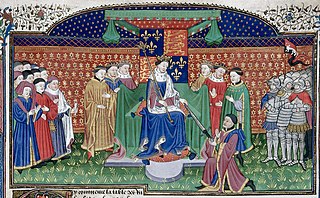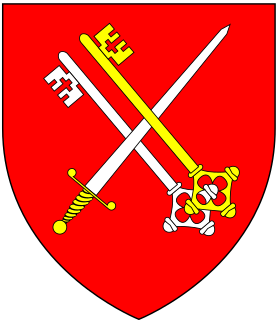Related Research Articles

John Stafford was a medieval English prelate and statesman who served as Lord Chancellor (1432–1450) and as Archbishop of Canterbury (1443–1452).

William of Kilkenny was a Lord Chancellor of England and Bishop of Ely.
Cuthbert was a medieval Anglo-Saxon Archbishop of Canterbury in England. Prior to his elevation to Canterbury, he was abbot of a monastic house, and perhaps may have been Bishop of Hereford also, but evidence for his holding Hereford mainly dates from after the Norman Conquest of England in 1066. While Archbishop, he held church councils and built a new church in Canterbury. It was during Cuthbert's archbishopric that the Diocese of York was raised to an archbishopric. Cuthbert died in 760 and was later regarded as a saint.
Aldhun of Durham, also known as Ealdhun, was the last Bishop of Lindisfarne and the first Bishop of Durham. He was of "noble descent".
Æthelgar was Archbishop of Canterbury, and previously Bishop of Selsey.
Æthelwine was the second bishop of Lindsey from around 680, and is regarded as a saint.
Wilfrid II, name also spelled Wilfrith, also known as Wilfrid the Younger, was the last Bishop of York, as the see was converted to an archbishopric during the time of his successor.

The Bishop of Winchester is the diocesan bishop of the Diocese of Winchester in the Church of England. The bishop's seat (cathedra) is at Winchester Cathedral in Hampshire. The Bishop of Winchester holds ex officio the office of Prelate of the Most Noble Order of the Garter since its foundation in 1348, and Bishops of Winchester often held the positions of Lord Treasurer and Lord Chancellor ex officio. During the Middle Ages, it was one of the wealthiest English sees, and its bishops have included a number of politically prominent Englishmen, notably the 9th century Saint Swithun and medieval magnates including William of Wykeham and Henry of Blois.

The Bishop of Salisbury is the ordinary of the Church of England's Diocese of Salisbury in the Province of Canterbury. The diocese covers much of the counties of Wiltshire and Dorset. The see is in the City of Salisbury where the bishop's seat is in the Cathedral Church of the Blessed Virgin Mary. The current bishop is Stephen Lake.
Edmund was Bishop of Durham from 1021 to 1041.
Alexander de Stavenby was a medieval Bishop of Coventry and Lichfield.
Roger Weseham was an English medieval Bishop of Coventry and Lichfield.
Roger de Meyland was a medieval Bishop of Coventry and Lichfield, England.
John the Chanter was a medieval Bishop of Exeter.

Peter Quinel was a medieval Bishop of Exeter. He became a canon of Exeter Cathedral in 1276 and his episcopate began in 1280 and continued until he died in 1291. He issued a set of rules governing the clergy in his diocese and the required furnishing of churches and continued the rebuilding efforts at Exeter Cathedral.

John Stanberry was a medieval Bishop of Bangor and Bishop of Hereford.
John Arundel was a medieval Bishop of Coventry and Lichfield and Bishop of Exeter.
The Bishop of Cornwall was the bishop of a diocese which existed between about 930 and 1050. Nothing is known about bishops in the post-Roman British Kingdom of Cornwall, but by the mid-ninth century Wessex was gaining control over the area, and between 833 and 870 a bishop at Dinuurrin, probably Bodmin, acknowledged the authority of the Archbishop of Canterbury. There may have been another bishop at St Germans. By the end of the century Cornwall was part of the diocese of Sherborne, and Asser may have been appointed the suffragan bishop of Devon and Cornwall around 890 before he became bishop of the whole diocese. When he died in 909, Sherborne was divided into three dioceses, of which Devon and Cornwall were one. In Æthelstan's reign (924-939) there was a further division with the establishment of a separate Cornish diocese based at St Germans. Later bishops of Cornwall were sometimes referred to as the bishops of St Germans. In 1050, the bishoprics of Crediton and of Cornwall were merged and the Episcopal see was transferred to Exeter.
Beornstan was an English Bishop of Winchester. He was consecrated in May 931. He died on 1 November 934. After his death, he was revered as a saint.
References
- Fryde, E. B.; Greenway, D. E.; Porter, S.; Roy, I. (1996). Handbook of British Chronology (Third revised ed.). Cambridge, UK: Cambridge University Press. ISBN 0-521-56350-X.
- Orme, Nicholas (2000). The Saints of Cornwall. Oxford, UK: Oxford University Press.